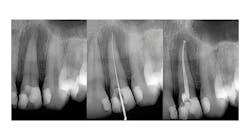"The 6 list" is a recurring feature exploring various topics on oral health, curated for both patients and dental professionals to share with their patients. "6 ways to manage dental anxiety" was medically reviewed by David R. Rice, DDS, chief editor of DentistryIQ. This content has been updated as of September 2024.
For many, “root canal” is a phrase that calls to mind dental torture. But it’s actually a common, relatively painless, if often misunderstood procedure. In general, your dentist will recommend root canal therapy—the removal of the pulpy material deep within your tooth—to save a tooth that’s in jeopardy of being lost.
But how does this happen to a tooth to begin with? Here are six common reasons.
1. Decay
Your teeth have three layers: enamel (top), dentin (middle), and pulp (deepest). If a tooth develops decay—most often due to you not following a good oral hygiene routine—to the enamel or dentin, your dentist will most likely recommend a filling. But if the decay reaches the pulp, you’ll need a root canal to save the tooth.
2. Infection
There are a number of ways a tooth can become infected, including decay, periodontitis (gum disease), and a cracked tooth. Each of these can allow bacteria to get into a tooth, and if the bacteria reach the pulp, you may need a root canal.
3. Issues with a crown
Some people think that having a crown on a tooth can lead to the need for a root canal. In and of itself, this is not true—if your crown is done properly, it should last for many years and cause no issues. But crowns don’t always function perfectly, and in some cases, decay can get underneath them and reach the pulp.
4. Issues from a previous filling
Similarly, a filling that becomes compromised because of poor oral hygiene or how long it’s been in the mouth can allow bacteria to work their way into the tooth, sometimes even the pulp.
5. Cracked tooth
“Cracked tooth” is just what it sounds like and can result from damaging habits such as grinding, clenching, ice chewing, chewing on objects, and eating hard food. Treatment depends on the depth and severity of the crack. If the crack hasn’t yet reached the pulp, a dentist will often recommend a root canal and crown.
6. Repeated procedures on a tooth
Each time a tooth has work done on it, it becomes more vulnerable, particularly if it has large, deep fillings. Sometimes this can lead to a condition called chronic pulpitis, which happens when bacteria get into the pulp. Over time, the infection can cause the pulp to die; as well, old fillings or crowns can deteriorate, allowing bacteria to get into the pulp.
If you're concerned that you have an issue that could lead to a root canal, rest assured that it’s a common procedure—and not the stuff of dental nightmares. If your dentist thinks you need a root canal to save a tooth, most likely they’ll refer you to an endodontist, which is a dentist who specializes in root canal therapy.
About the Author
Elizabeth S. Leaver
Digital content manager
Elizabeth S. Leaver was the digital content manager for Endeavor Business Media's dental group from 2021-2024. She has a degree in journalism from Northeastern University in Boston and many years of experience working in niche industries specializing in creating content, editing, content marketing, and publishing digital and magazine content. She lives in the Boston area.


